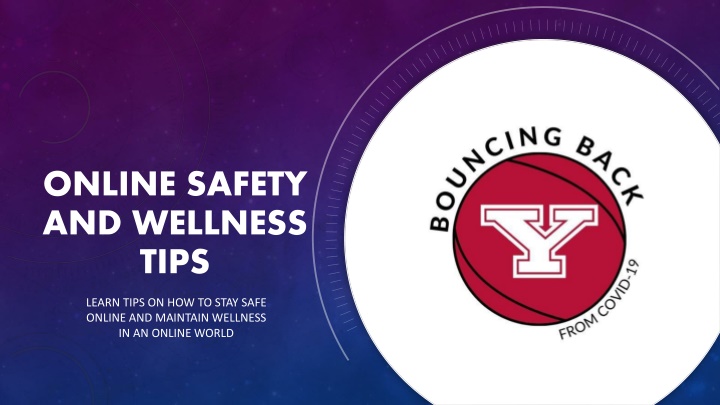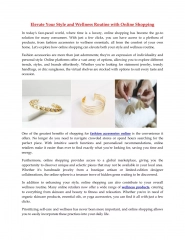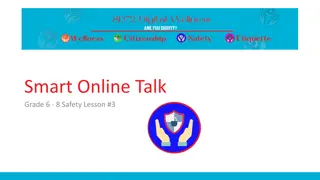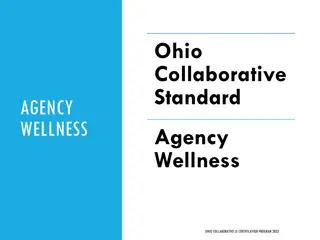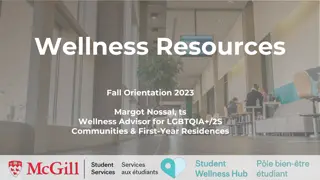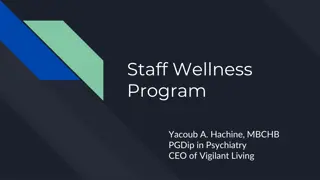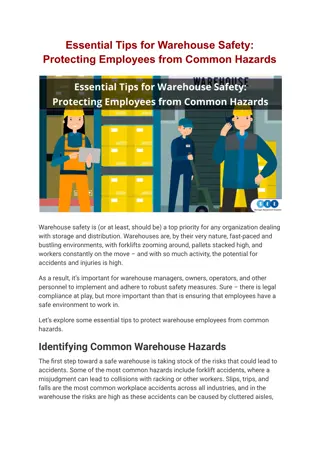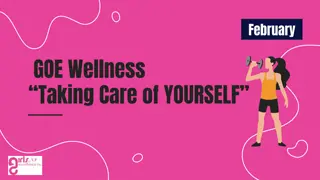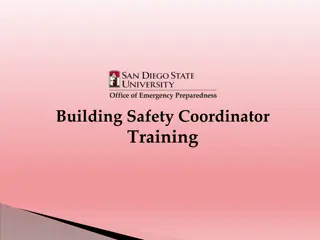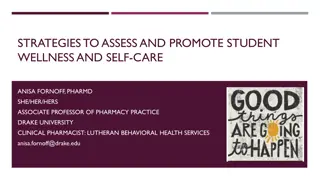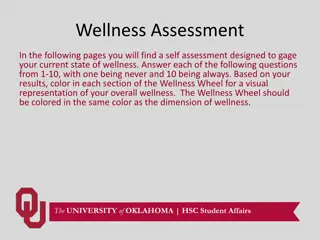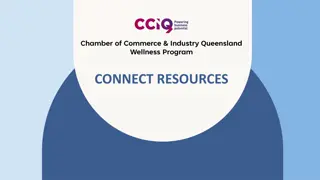Protecting Yourself Online: Safety Tips for Wellness
Stay safe online and maintain wellness with these essential tips. Learn about online safety measures, protect personal information, secure devices, and navigate the digital world with confidence. Discover how to safeguard your online presence and prioritize your digital well-being effectively.
Download Presentation

Please find below an Image/Link to download the presentation.
The content on the website is provided AS IS for your information and personal use only. It may not be sold, licensed, or shared on other websites without obtaining consent from the author.If you encounter any issues during the download, it is possible that the publisher has removed the file from their server.
You are allowed to download the files provided on this website for personal or commercial use, subject to the condition that they are used lawfully. All files are the property of their respective owners.
The content on the website is provided AS IS for your information and personal use only. It may not be sold, licensed, or shared on other websites without obtaining consent from the author.
E N D
Presentation Transcript
ONLINE SAFETY AND WELLNESS TIPS LEARN TIPS ON HOW TO STAY SAFE ONLINE AND MAINTAIN WELLNESS IN AN ONLINE WORLD
OBJECTIVES What is the average amount of time people are spending on the internet per day? What is the average amount of time people are spending on social media per day? Online safety 101: How can you protect yourself online? Updates Personal information Photos Scams Passwords Shopping Online friendships How to take care of yourself in a world that is always online
ACCORDING TO THE STATISTA RESEARCH DEPARTMENT DURING THE YEAR OF 2020, PEOPLE SPENT SEVEN HOURS PER DAY ON THE INTERNET. OUT OF THOSE SEVEN HOURS, TWO OF THOSE HOURS WERE SPENT USING SOCIAL MEDIA.
ONLINE SAFETY: PROTECTING YOURSELF ONLINE Keep up with updates and protect your device with an antivirus: The first step at ensuring your safety online is keeping up with your device s updates, as well as any external updates on browsers and antivirus softwares. *If you have not already, download an antivirus system onto your computer! A trustworthy and free antivirus is AVG.
ONLINE SAFETY: PROTECTING YOURSELF ONLINE Keep personal information private: According to the U.S. Department of Justice, the sharing of personal information online is one of the biggest online safety risks. Do not share your address, phone number, passwords, credit status, social security number, or bank account information online. This might seem like common sense, but social media invites us to share personal information online every day.
ONLINE SAFETY: PROTECTING YOURSELF ONLINE Sharing photos: Have you noticed that your smartphone attaches a GPS location to photos? This will allow other people to see where photos were taken- and when! To ensure safety, take a look at your phone s settings and disable location services.
ONLINE SAFETY: PROTECTING YOURSELF ONLINE Beware of visiting certain sites, clicking links, and downloading files: When you receive an unsolicited email from an unknown person, website, company, etc. that is requesting personal information or asking you to download something onto your computer, think twice! Clicking links/downloading attachments from unknown sources can lead to viruses on your computer, compromising your safety. *If you are questioning whether a site, company, or link is legitimate, a quick Google search can show you if others have reported it as untrustworthy.
ONLINE SAFETY: PROTECTING YOURSELF ONLINE Pick a strong password, and make sure to change it up from site to site: Make your password 10 or more characters with a special character (!@#%^&*) and a number. Do not include any personal information! Consider changing up your passwords across different accounts, as all of your accounts run the risk of being hacked if your password becomes compromised. To ensure optimal safety, change your passwords every 3 months.
ONLINE SAFETY: PROTECTING YOURSELF ONLINE Online shopping: Online shopping is simple- and convenient. Avoid purchasing anything from sites that do not have a secure check-out. A good indication that a site has a secure check-out is if address line includes HTTPS. If there is no S at the end of the address line of the checkout page, it may not be secure. Another way to tell whether a site is secure is if there is a padlock displayed to the left of the address line.
ONLINE SAFETY: PROTECTING YOURSELF ONLINE Online relationships: Avoid sharing too much information with someone who you have met online, especially on an online dating platform. If you choose to meet with someone you met online in person, meet in a public place. When in doubt, use information (i.e. their name, age) you know about someone to properly research who they are. If information is scarce and you feel as though they are being dishonest with you, keeping your distance is your best bet.
HOW DO YOU PLAN TO PROTECT YOURSELF ONLINE?
HOW TO MAINTAIN WELLNESS IN A WORLD THAT IS CONSTANTLY ONLINE How do you know when social media has been impacting your mental health? From helpguide.org: If you spend more time online than in person When you are comparing yourself and your life to others If you feel as though you are being cyberbullied Social media use is distracting you from work and school You feel isolated
HOW TO MAINTAIN WELLNESS IN A WORLD THAT IS CONSTANTLY ONLINE In order to improve your mental health, modify social media use: Try slowly reducing the time you spend on social media. Most smartphones track how much time you spend on certain apps- find out how long you spend using social media. If you spend an average of 2 hours per day on social media platforms, perhaps try reducing that time in small intervals to help with adjustment. It may also be helpful to disable notifications, so you are not tempted to check. * Pro-tip: removing social media apps from your home-screen can be helpful if you want to reduce the time you spend on them but do not want to completely remove them.
HOW TO MAINTAIN WELLNESS IN A WORLD THAT IS CONSTANTLY ONLINE Set aside time to be present offline: Make time each week to be present with your friends and family offline and keep phones away! For example, if you are out to dinner, encourage everyone to put their phones in the middle of the table to limit use. Social media can be a great way to keep in touch on and offline-if you find yourself frequently communicating with friends online, ask to see them in person, even if it is just helping them run a quick errand or grabbing coffee to catch up.
HOW TO MAINTAIN WELLNESS IN A WORLD THAT IS CONSTANTLY ONLINE Engage in reflective activities: Take some time to reflect on your life. Think about the role social media plays- do you feel as though social media platforms play a positive or negative impact on your life? Record your thoughts in a journal or a notebook you have nearby.
HOW TO MAINTAIN WELLNESS IN A WORLD THAT IS CONSTANTLY ONLINE Express gratitude: Comparison is often the thief of joy. Social media creates room for us to compare ourselves to other people- their physical appearance, accomplishments, stage of life, etc. Take a step back and think of the things in life that you are grateful for and accomplishments you have made. *Remember, social media usually only includes the highlights of people s lives. Not everything you see is reality!
HOW TO MAINTAIN WELLNESS IN A WORLD THAT IS CONSTANTLY ONLINE Find a hobby, or something you enjoy doing: It is easy for us to spend our free-time browsing the internet or using social media. Perhaps picking up a new hobby such as reading, painting, learning how to play a music instrument, or moving your body in a meaningful way can be a substitute for time you might otherwise spend online.
HOW DO YOU PLAN TO MAINTAIN WELLNESS?
THANK YOU Keep up with us! Follow us on Instagram and visit our website for our upcoming events and access resources for all things wellness: @ysu_bouncingback https://ysu.edu/bouncing-back
